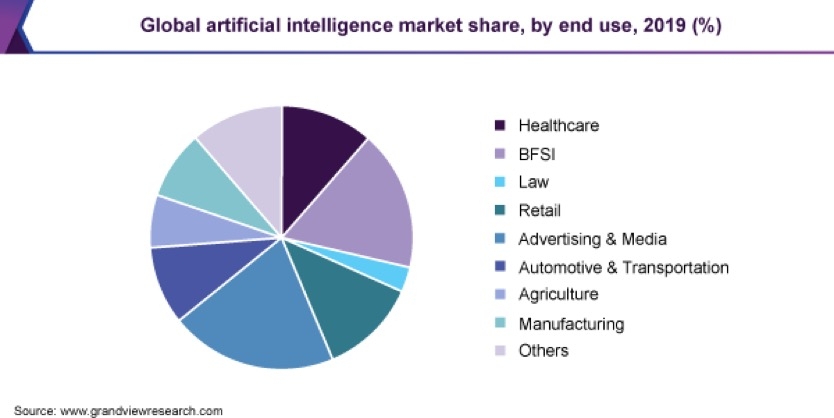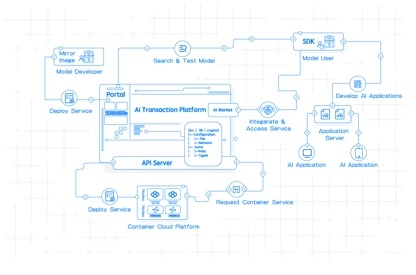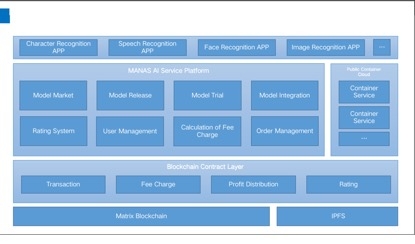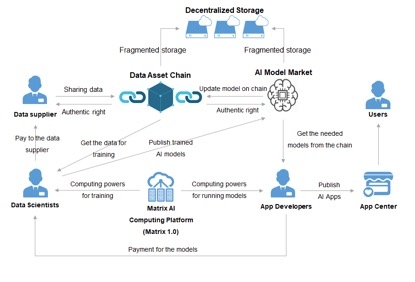MANAS—Empower AI with Blockchain
The Great Potential of AI
Artificial Intelligence is a broad field of study that involves computer science, biology, philosophy, etc. Its definition is often vague and up to debate, but essentially, AI is about teaching machines to think, analyze and make judgments just like humans do by imitating how the human brain works.
Today, AI has become the driving force for the next round of technological and industrial revolution, changing society and people’s lives in permanent ways. In recent years, the AI industry has gotten hotter and hotter, and its market is constantly expanding. But although the number of new companies is still growing, its rate has slowed down quite a bit. Funding for the AI industry is constantly increasing, and capital is favouring grown companies as opposed to start-ups. With machine learning, especially deep learning, as the focus, the AI industry is making significant achievements in computer vision, speech recognition, natural language and other areas.
The Scale of the AI Industry on the Rise Around the Globe
Next-generation AI is gaining traction around the globe. It is both a growth engine and a strategic industry for future society. As AI-related research and development pick up speed and AI technologies find commercial uses, the market is getting larger, attracting more capital. In 2019, the global AI industry was worth 520 billion USD, up 30% compared to the previous year. Its fast development has caught the attention of many countries, and most developed countries have made strategic arrangements surrounding the core technologies, capital support, talents and industry standards of AI in an attempt to take primacy in the competition of the future.

Picture: Market Share of AI Across Sectors
Increasing Number of AI Companies
With the AI industry on the rise, the number of AI companies is also increasing. Although tech giants dominate the market with their incomparable access to technology, talents and capital, there is also gold among start-ups, whose flexibility and innovation offer constant surprises. By the end of 2019, the number of AI start-ups totaled nearly 20,000, with the United States being home to most of them, followed by China and the UK. While American and European companies have a lead in natural language processing, machine vision and AI robotics, Japanese and Korean companies are ahead in semiconductors.
Increasing Global Funding for AI
With such a promising outlook, the AI industry is seeing increasing rounds of funding attracting more and more investment. In 2019, AI start-ups around the globe raised 26.6 billion USD in total in over 2,200 transactions, setting a record. At the same time, the percentage of seed-round and angel-round investments is declining, suggesting that it’s increasingly difficult for start-ups to attract funding as investments flow into medium and large AI companies.
AI Service Is the Breakthrough Point
The prerequisite of AI is machine learning, which is essentially fueled by computing power. Machine learning needs data for material and generates algorithm models as results, while these algorithm models can be used to build AI services and applications which will have tremendous value for society.
Currently, the mainstream way to provide AI services is through an API, which helps developers to easily integrate technologies or services into programs or products they are building. For example, developers may add individual person recognition features to album apps through a facial recognition API. Thanks to the API, they no longer have to program facial recognition codes from the start, nor even thoroughly understand its mechanism. New features can be accessed on cloud when they are enabled on applications through API. API can be used for different purposes, including computer vision, computer speech recognition, natural language processing, search, knowledge mapping, translation, and emotion detection.
In the next few years, the growth of the AI industry will be primarily driven by the growth of AI services.

Picture: Projected Growth of the AI Service Market in Coming Years
Blockchain-Empowered AI—Better AI
Without doubt AI will drive human society forward for the next 40 years. It is gathering momentum in transportation, finance, industry, energy, media and other sectors. The application of AI is digitalizing these industries, inspiring change or even total transformation.
To create a better environment for AI and make AI serve humans more smoothly, Matrix is coming up with a brand new structure. In Matrix 1.0, AI was used to empower blockchain, drastically improving its performance, security and public benefit. On to Matrix 2.0, this will be an AI ecosystem managed through a highly efficient blockchain.
Under this framework, AI is no longer centralized but will be managed and utilized through a decentralized blockchain. Every node on this blockchain will participate in decision-making and execution through the consensus mechanism of the network. This will eliminate the possibility of centralized AI awakening someday. At the same time, AI nodes in the decentralized network can better work together to serve humans.
About MANAS
The core of the decentralized AI ecosystem that Matrix is building is MANAS (Matrix AI Network AI Service). MANAS is an AI service platform built on Matrix’s highly efficient blockchain. It aims to serve as a smart, secure, fair and trustworthy marketplace for developers and clients alike.
The AI models released on MANAS are not finished products like smartphone apps but integrated into the end-users’ products through cloud services for more usage scenarios.

How to Use MANAS
There are four main parts to MANAS.
1. Service deployment and release: Algorithm scientists can deploy models they have developed through MANAS, and MANAS will deploy these services onto distributed container cloud platforms through the Matrix Mainnet.
2. Service trial: People can search for the services they want on MANAS, and these services are available for trial.
3. Service purchase: If people decide to purchase a service after trying, they can pre-order any number of uses they wish for.
4. Service integration: After purchase, an SDK becomes available for download. Follow instructions to integrate the correct version of SDK into your code, and you can use the service.

Picture: The Structure of MANAS
The Structure of MANAS
There are five parts to MANAS: bottom network, contract layer, service platform, container cloud and application layer.
1. The bottom layer is made up of the Matrix Mainnet and its distributed storage network. It is for authentication, bookkeeping and secure storage.
2. The contract layer is for facilitating transactions and storing transaction history, fee charges, reward distribution and other information.
3. The service platform hosts core functions of MANAS, including model launching, authentication, integration, usage, payment, etc.
4. The container cloud accelerates the response speed of services and provides mirroring for existing AI services improving their efficiency.
5. The application layer is the interface directly presented to users after they have finished accessing API and integrating SDK.

Picture: The Structure of MANAS
The Competitive Advantage of MANAS
The competitive advantage of MANAS will come in three ways: lower development barrier, more algorithm scientists and more users.
How does MANAS lower the development barrier?
AI is a brand new area for most developers. Matrix is building MANTA, the perfect tool for scientists and engineers entering the AI industry, The core of MANTA is auto-machine learning, which will lower the entry barrier to machine learning allowing people with basic computer knowledge but no AI background to participate in AI programming. Creative people with ideas but no AI knowledge can also build their own AI applications and services. Like open platforms such as iOS or Android, MANAS is also building a platform featuring diversity, and the addition of MANTA to the Matrix ecosystem will no doubt facilitate this process.
How does MANAS attract more algorithm scientists?
Besides the entry barrier, another concern for algorithm scientists is intellectual property protection. Matrix has introduced NFT using the two core technologies of distributed storage to protect the interests of algorithm scientists. When an AI algorithm has been trained, it will get authenticated on the Matrix Mainnet, and a transferable NFT will be minted and stored in the distributed storage network.

Picture: Matrix’s NFT Authentication Platform
Besides building technological advantages, Matrix is also actively exploring channels to attract algorithm scientists into its ecosystem. An example of this is Matrix’s strategic partnership with the renowned Japanese AI algorithm provider Bitgrit. In the future, Matrix will bring over 2000 top-notch algorithm scientists from Bitgrit, and people will get direct access to their quality algorithms and services.
How does MANAS acquire more users?
Decentralization is the prerequisite for a vibrant blockchain project. Matrix will not operate MANAS by itself but will share open API, SDK and the necessary development tools with everyone who has faith in the future of the platform. This will encourage more and more users to join.
Decentralized vs Centralized:Which one is the future?
Currently, AI services are an important part of the product lines of mainstream cloud computing providers such as Alibaba Cloud, AWS, Azure. These companies all have their AI service platforms. Therefore, one may wonder what advantages does MANAS has compared with traditional centralized cloud computing platforms? Can MANAS thrive in this competitive market space?
A More Competitive Ecosystem
The difference between centralized and decentralized platforms lies in who provides the AI services. Traditional centralized AI service platforms are providers themselves. As we know, the long-term development of a platform relies on a vibrant and competitive ecosystem. Just like biological ecosystems thrive in diversity, MANAS will facilitate diversified services by providing a structure like iOS or Android for independent AI algorithm scientists to deliver their services. Free market competition will motivate these services to self-improve and drive MANAS forward to a better future.
Cheaper and More Individualized Services
Different from centralized platforms, MANAS adopts a C2C business structure, as a perfectly competitive market offers the lowest service cost. At the same time, MANTA’s auto-machine learning will remove the entry barrier to MANAS, and Matrix’s decentralized computing network will provide scientists with cheap computing power, which also guarantees the competitive pricing of services and applications on MANAS.
As MANAS is a C2C platform, it will be primarily demand-driven in contrast to centralized platforms. It will satisfy a diversity of consumer demands and niche markets so that every aspect of people’s commercial life will benefit from the AI revolution.
The MANAS Trinity—A Mutually Beneficial Business Model
Different from the B2C service model of conventional centralized AI service platforms, the MANAS model is multi-lateral, and each side plays an indispensable role and wins the corresponding benefits.
1. Algorithm scientists: As AI service providers, they build the core products of MANAS and make a considerable profit doing so.
2. Users: On MANAS, users can find AI services matching their individual needs at competitive prices.
3. Miners: When scientists train new AI algorithms or when users run AI services, the computing power that support these functions is provided by miners. Leasing idle computing power becomes an additional source of income for miners.

Picture: The Trinity of Algorithm Scientists, Miners and Users
MANAS——Matrix’s Value Platform
Matrix 2.0 plans to build a decentralized AI ecosystem. The value anchor for this ecosystem is data, which is the source material people use to produce and operate AI services, and MANAS is the platform where this will happen.

Picture: Blockchain-Based AI Ecosystem in Matrix 2.0
The arrival of MANAS will mean more profits for the AI model builders and miners of the Matrix ecosystem. As the platform develops and clients with all types of needs join the ecosystem, there will be a huge demand for not only algorithm models and but also data to support algorithm training. People who provide data for MANAS will be as well rewarded as algorithm scientists and miners.
More importantly, all the transactions that take place on MANAS will be made in MAN only, which will further boost MAN’s demand and liquidity.
According to estimation, AI services will be a 4 billion USD business by 2024. If MANAS can become a unicorn in distributed AI with more than 15% market share, this will be a remarkable achievement for everyone who is invested in the Matrix ecosystem.
Last updated